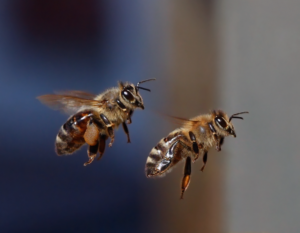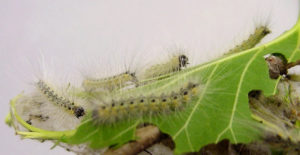By Siraj Asfahani | February 13, 2018
Here at The Lakota Group, we’ve been talking about how to best engage communities so that the projects we work on are truly community driven. This conversation has been happening simultaneously with a personal exploration of biomimicry and how it can be applied to urban planning.
Biomimicry is the practice of looking to nature to find creative solutions to man-made problems. It’s based on the idea that sustainability is something that has existed long before we made a word for it—ecosystems exist because of the ecological balance that developed over time. Any challenge we have, nature has already solved. By framing our issues through a biological lens, we can begin to find creative biological solutions.
There are endless inspirational examples of how our society has begun to use biomimicry. In Zimbabwe, the structure of termite mounds helped to design internal climate control systems in buildings. In Germany, scientists trying to solve the problem of birds dying from flying into the glass of skyscrapers found a solution in spider webs, which contain UV reflective strands that make them visible to birds. In Japan, the beak of the kingfisher bird, which allows for splashless entry into water, inspired the redesign of the nose of high-speed trains to reduce the air pressure changes in tunnels that resulted in loud booms.
Though it may not be the first thing that comes to mind when you think of sustainability, a lack of community engagement is a critical sustainability issue. If our communities aren’t informed and invested in shaping their future, then the plans for the future won’t serve them. This can result in increased inequity in communities and public mistrust—the opposite of what good planning is intended to provide.
So, what can nature teach us about effectively engaging communities?
Scout Bees and Waggle Dances
One example we can look to is the ever-important honeybee. According to Peter Miller in an article entitled Swarm Theory in National Geographic Magazine, when a honeybee hive outgrows itself, several “scout” bees are designated to visit potential sites for a new hive (2007). The scout bees return to the hive after their site visits and describe how promising the location was through what is endearingly referred to as a “waggle dance”. Based on how desirable various sites are, other scouts visit the top locations. Once the number of bees at a new site reaches 15, the group returns to the old hive and communicates the decision to relocate to this new hive, and the rest of the swarm follows.

This development of quorum among bees can be applied to community engagement, and resembles something we often create for planning projects—a steering committee. When we help our clients assemble a steering committee for a project, we generally want representatives from major institutions, businesses, and community organizations that may be impacted by the project. This group meets regularly throughout the project and gives feedback and direction on its progress to their own network. Though the goals are noble, the committee structure can also feel stale—a committee member’s job is to come to meetings and give feedback, but they can often act as a silo, not spreading the word outside of the selected group.
What if instead of creating steering committees, we created groups of scout bees? To change the dynamics and expectations around the purpose of a “committee”, the scout bees could be referred to as Community Ambassadors. In addition to being part of regular project updates and progress meetings, these ambassadors would be tasked with going back to their respective circle of influence and do a “waggle dance”—or in human terms, communicate how the project is going. They must spread the word: What is the project all about? How will it impact you? How close are we to achieving the community’s vision for the future? If all the community ambassadors do this and return to the group with feedback, the more likely it is that a community’s truly representative vision will emerge. At public workshops, each community ambassador can be responsible for encouraging their neighbors to attend and could have their own table where they lead a discussion around the project to get valuable feedback.
Identifying a diverse spectrum of community members to represent the community is critical to building public will. Unfortunately, many vulnerable groups are often left out of the planning process because of lack of time, language barriers, or childcare needs. One method to overcome this is to provide a stipend to those who serve as Community Ambassadors—let’s call it honey. This can help ease some of the burdens of involvement and create more personal ownership over the process.
Pest Control
Another example of biological systems depending on effective communication are plant species that are experiencing a pest problem. According to Melissa Pernell at the Biomimicry search engine, AskNature, when a pest begins to damage a plant, a chemical language emerges that can attract pest killing insects (2016). As the leaves of the plants are chewed, the leaves are able to detect the type of pest that’s buggin’ them (pun intended). The plant then releases an airborne odor to alert the presence of the pest. This serves a community benefit—not only does it attract predator insects or parasites who want to feed on the pest, it also lets nearby plants know that they might be in danger of similar pests.

In the planning world, we have all experienced pests that damper the community engagement process. From naysayers who are against anything having to do with a project from the get-go, to those who use the platform the planning team created for community input as a megaphone for their own unrelated project or protest. While we’re all for free speech, these pests often detract from the planning process and cast bad vibes on the whole project. Maybe we can take a page from the plants, and out-pest the pests. Identifying community members in advance who are engaged in a positive way can help change the tone when things start to go south. Everyone wants what is best for the community, and sometimes it takes someone else from the community to get everyone back on track, focusing on a positive vision for the future.
Community engagement is meant to leverage collective wisdom; to build public will to design plans that are truly community driven. But it is prudent to remind ourselves that collective wisdom extends beyond our human bubble. As nature begins to adapt to the world we’ve changed, it’s time to change our own systems to be more in line with nature.
Miller, P. (2007). Swarm Theory – National Geographic Magazine. [online] Ngm.nationalgeographic.com. Available at: http://ngm.nationalgeographic.com/2007/07/swarms/miller-text [Accessed 7 Feb. 2018].
Pernell, M., Team, A. and Team, A. (2016). Leaves communicate pest damage : Plants – AskNature. [online] AskNature. Available at: https://asknature.org/strategy/leaves-communicate-pest-damage/#.Wns8byXwaCg [Accessed 7 Feb. 2018]
